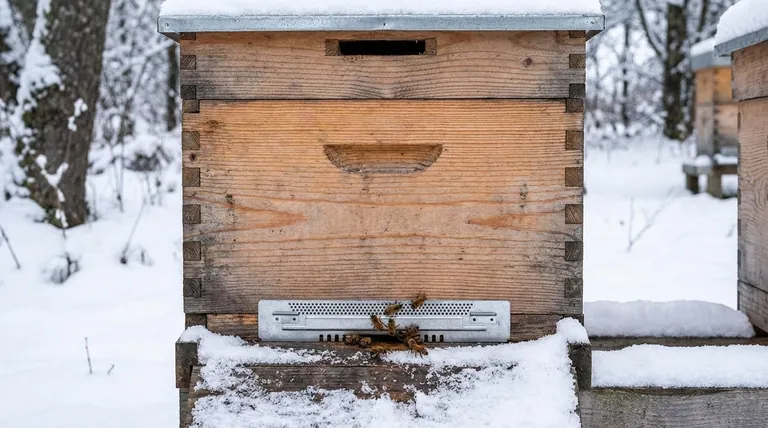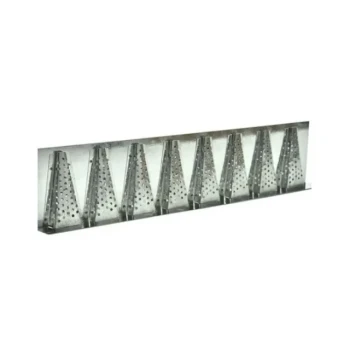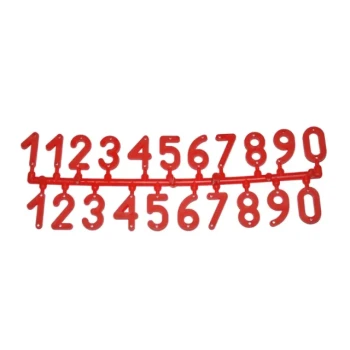Reducing a hive entrance for winter is a critical step that serves two primary functions: defending the colony from invaders and helping the bees regulate their internal climate against the cold. A smaller, more defensible opening is crucial for a colony's survival when its population and activity levels are at their lowest, making it easier to protect resources and conserve heat.
The core task of winter entrance management is to create a defensible, draft-reduced space that still allows for essential ventilation. An improperly managed entrance can lead to robbing, starvation from cold, or colony death from moisture buildup.

The Dual Threats of Winter: Robbers and Cold
During winter, a honey bee colony faces significant challenges from both external pests and the environment itself. A properly managed entrance is the first line of defense against both.
Fortifying the Castle: Defense Against Robbers
A winter bee cluster is smaller, more compact, and less active than a summer colony. This reduced population has a harder time defending a large, open entrance.
Pests like yellow jackets, wasps, and even bees from other struggling hives will try to rob the colony's precious honey stores. A small opening, often just an inch or two wide, is far more manageable for the guard bees to protect against these invaders.
Managing the Internal Climate: Reducing Drafts
Bees do not heat the entire hive; they heat their cluster by vibrating their flight muscles. This process consumes significant energy in the form of honey.
A large, open entrance allows cold winds to blow directly into the hive, creating drafts that force the cluster to burn through its food stores much faster. By reducing the entrance, you minimize this heat loss and help the colony conserve the energy it needs to survive until spring.
Understanding the Trade-offs: Ventilation is Non-Negotiable
While reducing the entrance is vital for insulation and defense, completely sealing the hive is a fatal mistake. The most common killer of bees in winter is not cold, but moisture.
The Dangers of Trapped Moisture
As bees metabolize honey, their respiration releases a significant amount of warm, moist air. In a poorly ventilated hive, this humid air rises and condenses into water droplets on the cold inner cover or top of the hive.
This condensation then drips back down onto the cluster. Bees can survive extreme cold, but they cannot survive being wet and cold.
The Golden Rule: Cold Kills, but Wet Kills Faster
This classic beekeeping adage highlights the critical balance you must strike. The entrance reducer helps with the "cold" part, but you must have a plan for the "wet" part.
Your goal is to create a system where cold, dry air can enter from the bottom while warm, moist air can escape from the top.
Ensuring Proper Airflow
An entrance reducer is only one part of a complete winter ventilation system. To prevent deadly condensation, you must provide a small upper exit for moist air.
This is often achieved by placing a small shim or popsicle sticks under the corners of the outer cover to create a small gap. Alternatively, a "quilt box" filled with wood shavings can be placed on top of the hive to absorb moisture and provide insulation.
Practical Winter Entrance Management
Implementing this strategy is straightforward but requires periodic attention throughout the winter.
Installing the Reducer
Standard entrance reducers are wooden blocks with different-sized notches. For winter, you should install the reducer so the smallest opening is available to the bees. This simultaneously reduces drafts and keeps mice from entering the hive to nest.
The Problem of Blockages
Natural bee mortality occurs throughout the winter. As bees die, their bodies can fall to the bottom board and accumulate, potentially blocking the small winter entrance.
A blocked entrance prevents living bees from exiting the hive for "cleansing flights" on warmer days and also cuts off the supply of fresh air.
Keeping the Entrance Clear
Periodically check the hive entrance, especially after a long cold snap. If you see it is blocked with dead bees, use a thin stick, a piece of wire, or an old bee brush to gently clear the opening. This can be done without opening the hive or disturbing the cluster.
A Note on Horizontal Hives
In Langstroth hives, you reduce the entrance. In horizontal hives (like a Top Bar or Layens), you reduce the entire interior volume of the hive using a "follower board." This shrinks the space the bees must keep warm, achieving the same energy-saving goal through a different method.
Making the Right Choice for Your Goal
Your specific winterization strategy should be adapted to your local climate and challenges.
- If your primary focus is fending off heavy robbing pressure: Use the smallest possible entrance (e.g., 1/2 to 1 inch wide) and ensure a mouse guard is in place.
- If your primary focus is surviving a very cold, windy climate: Ensure your entrance reducer is secure and consider wrapping the hive, but never sacrifice upper ventilation to do so.
- If your primary focus is managing a damp, humid winter: A reduced entrance is still necessary, but your absolute priority is creating an upper vent or using a quilt box to allow moisture to escape.
Ultimately, managing the hive entrance is about creating a stable, secure, and dry home, giving your colony its best chance to thrive through the winter.
Summary Table:
| Winter Entrance Goal | Key Benefit | Risk if Ignored |
|---|---|---|
| Defense Against Robbers | Protects honey stores from pests and other bees | Colony starvation from robbed resources |
| Heat Conservation | Reduces drafts, saving energy and honey | Faster depletion of food stores, leading to starvation |
| Moisture Management | Allows for essential ventilation when paired with upper vents | Condensation, wet bees, and colony death |
Ensure your apiary is prepared for winter with professional-grade equipment from HONESTBEE. We supply durable, well-designed entrance reducers, mouse guards, and ventilation solutions tailored for commercial apiaries and beekeeping equipment distributors. Our wholesale-focused operations ensure you get reliable, bulk supplies to protect every hive. Don't let winter threats compromise your colonies—contact our experts today to discuss your needs and secure your seasonal inventory!
Visual Guide

Related Products
- Beehive Entrance Reducer Guardian Metal Hive Entrance for Bees
- Steel Round Disc Entrance Reducer for Flexzion Bee Hive Nuc Box Gate
- Professional Reversible Beehive Hive Entrance
- Multi-Functional Sliding Hive Entrance for Beekeeping
- Multi-Functional Rotary Hive Entrance Disc for Beekeeping
People Also Ask
- What are the different types of entrance reducers available? A Guide to Protecting Your Hive
- How can a Langstroth hive entrance be adjusted? Mimic Natural Bee Preferences for a Healthier Hive
- What size is the entrance hole in a native bee hive? The 13mm Standard for a Thriving Colony
- What happens if you seal an entrance to a bee hive? Avoid a Costly Structural Disaster
- What are the different entrance sizes for an 8 or 10-frame Langstroth hive? A Guide to Seasonal Management



















